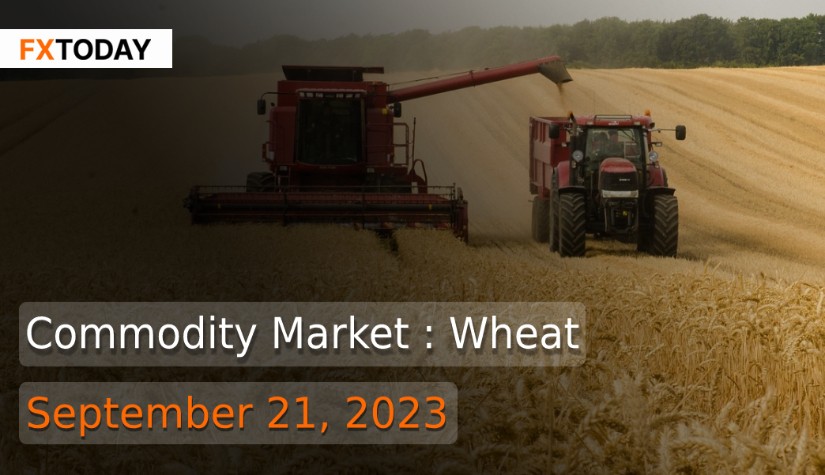Wheat Prices Face Short-Term Pressure but Hold Long-Term Upside Potential
In the world of wheat trading, recent developments indicate an upward movement attributed to oversold indicators. Weather factors played a significant part, as Australia grappled with scorching and arid weather conditions, while Argentina encountered a shortage of immediate rainfall. Russia maintained its stronghold on the export market thanks to its competitive pricing, and there were reports of grain shipments originating from Ukrainian ports, even in the absence of a formal export agreement.
Regarding the 2023/24 U.S. all wheat outlook, there have been no significant changes this month. Exports underwent some by-class adjustments, while the projected season-average farm price remains steady at $7.50 per bushel.
Globally, the outlook for 2023/24 indicates a decrease in supplies, consumption, exports, and ending stocks compared to the previous month. The decline in supplies is primarily attributed to reduced production in Australia, Canada, Argentina, and the EU, partially offset by an increase in Ukraine's production. If realized, this would mark the first year-to-year decline in global wheat production since 2018/19.
Despite the decline in global supplies, world consumption remained largely unchanged, with reduced Food, Seed, and Industrial use compensated by increased feed and residual use. This increase in feed and residual use is attributed to wet weather during harvest in China and the EU, which is expected to result in the use of lower-quality wheat for animal feed. Global trade decreased by 2.1 million tons, with reductions in exports from Australia, Canada, and the EU partly offset by increases in Russia and Kazakhstan. World ending stocks saw a significant reduction of 7.0 million tons, reaching 258.6 million, the lowest since 2015/16. Many countries, particularly major wheat exporters, experienced tightened ending stocks.
In the futures market, Chicago wheat saw gains driven by uncertainty surrounding Ukraine's exports and concerns about dry weather affecting wheat production in Australia and Argentina. The departure of a cargo vessel carrying wheat from Ukraine's Chornomorsk port raised hopes of improved grain shipments. However, the ban on food imports from Ukraine by three eastern European countries could pose challenges for Ukrainian grain exports.
Additionally, Russia's consistent price advantage continued to influence the global wheat market, and the influx of Russian wheat contributed to the decline in CBOT wheat futures earlier. While weather conditions, such as hot and dry weather in the southern hemisphere and Australia's declaration of an El Nino event, added support to wheat prices.
Moving forward, the profitability of U.S. grain elevators storing wheat is improving, driven by better futures market carries for all three major wheat classes. However, there remains a risk of a sharp rally in wheat prices, especially if disruptions occur in Russian exports through the Black Sea. The cost of storing grains, including wheat, remains high due to rising interest rates, making it challenging for elevators to profit from wider carries.
The influx of cheap Russian wheat and the strength of the U.S. dollar continue to pose challenges to U.S. wheat exports. Additionally, wet weather in China damaged a significant portion of its wheat crop, potentially leading to increased wheat imports.
Looking ahead, addressing climate change's impact on wheat is crucial, as demand for this staple crop is expected to rise significantly. Wheat is highly susceptible to temperature increases, and scientists are exploring forgotten wheat varieties with potential resilience to heat, drought, and disease. Organizations like CIMMYT are actively involved in selecting and testing wheat seeds from around the world to develop climate-resistant wheat varieties. Research in this area is ongoing, with rising nighttime temperatures emerging as a new challenge for wheat resilience. Consequently, the short-term outlook for wheat might experience pressure due to stable demand and an ample supply in the immediate period. Conversely, a potential upward trajectory could emerge in the medium to long term owing to the uncertain and unpredictable nature of future weather conditions.
Data for Technical Analysis (5H) CFD US Wheat Futures - Dec 23 (ZWZ3)
Resistance : 588.60, 589.24, 590.27
Support : 586.54, 585.90, 584.87
5H Outlook
Source: Investing.com
Buy/Long 1 If the support at the price range 581.54 - 586.54 is touched, but the support at 586.54 cannot be broken, the TP may be set around 588.60 and the SL around 579.00, or up to the risk appetite.
Buy/Long 2 If the resistance can be broken at the price range of 588.60 - 593.60, TP may be set around 596.00 and SL around 584.00, or up to the risk appetite.
Sell/Short 1 If the resistance at the price range 588.60 - 593.60 is touched, but the resistance 588.60 cannot be broken, the TP may be set around 585.84 and the SL around 596.00, or up to the risk appetite.
Sell/Short 2 If the support can be broken at the price range of 581.54 - 586.54, TP may be set around 579.00 and SL around 591.00, or up to the risk appetite.
Pivot Points Sep 21, 2023 02:58AM GMT
|
Name
|
S3
|
S2
|
S1
|
Pivot Points
|
R1
|
R2
|
R3
|
|---|---|---|---|---|---|---|---|
| Classic | 583.14 | 584.87 | 585.84 | 587.57 | 588.54 | 590.27 | 591.24 |
| Fibonacci | 584.87 | 585.9 | 586.54 | 587.57 | 588.6 | 589.24 | 590.27 |
| Camarilla | 586.06 | 586.3 | 586.55 | 587.57 | 587.05 | 587.29 | 587.54 |
| Woodie's | 582.74 | 584.67 | 585.44 | 587.37 | 588.14 | 590.07 | 590.84 |
| DeMark's | - | - | 585.35 | 587.33 | 588.05 | - | - |
Sources: Hellenic Shipping News, Nasdaq
Maximize your knowledge: Blog
















